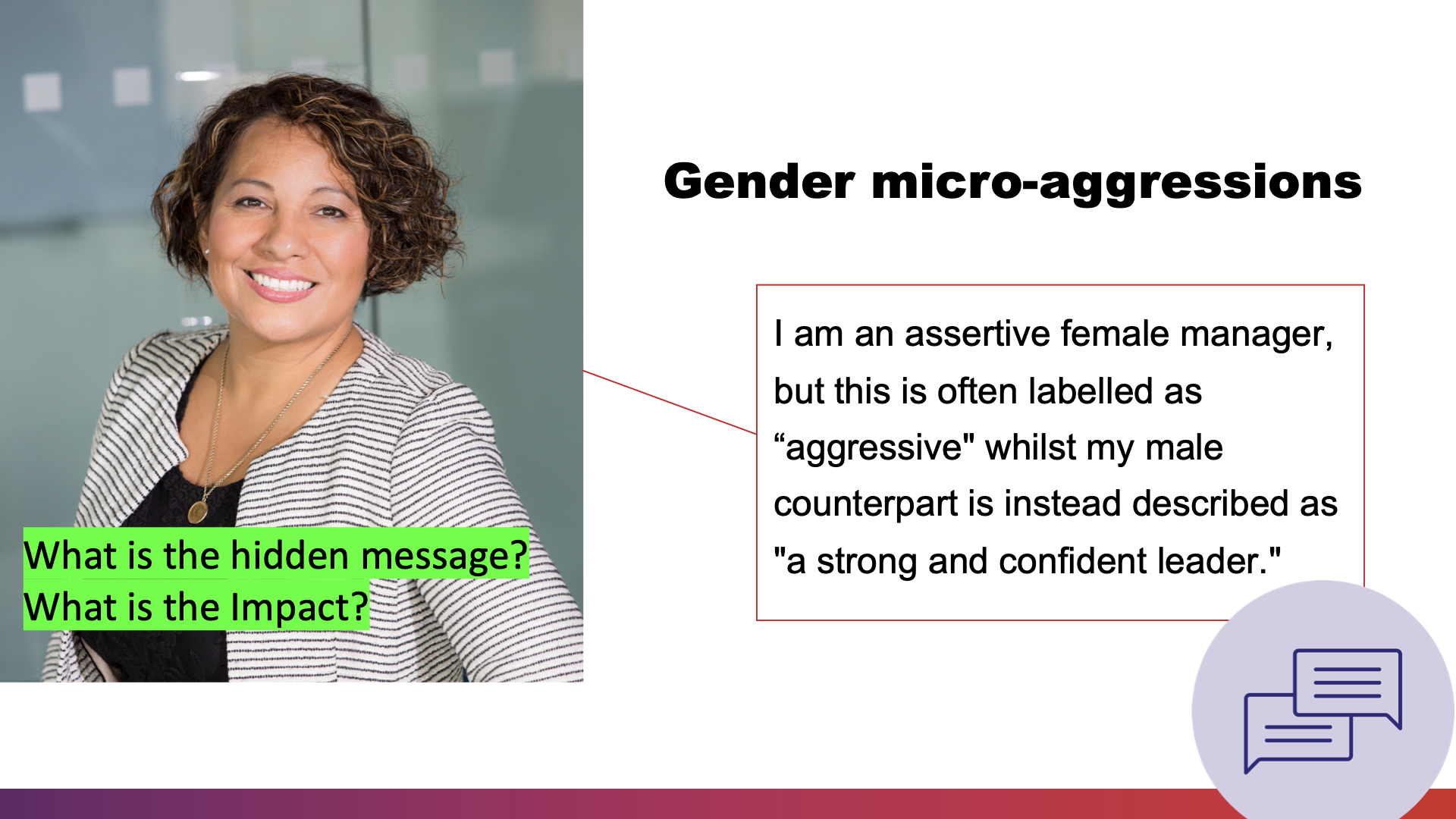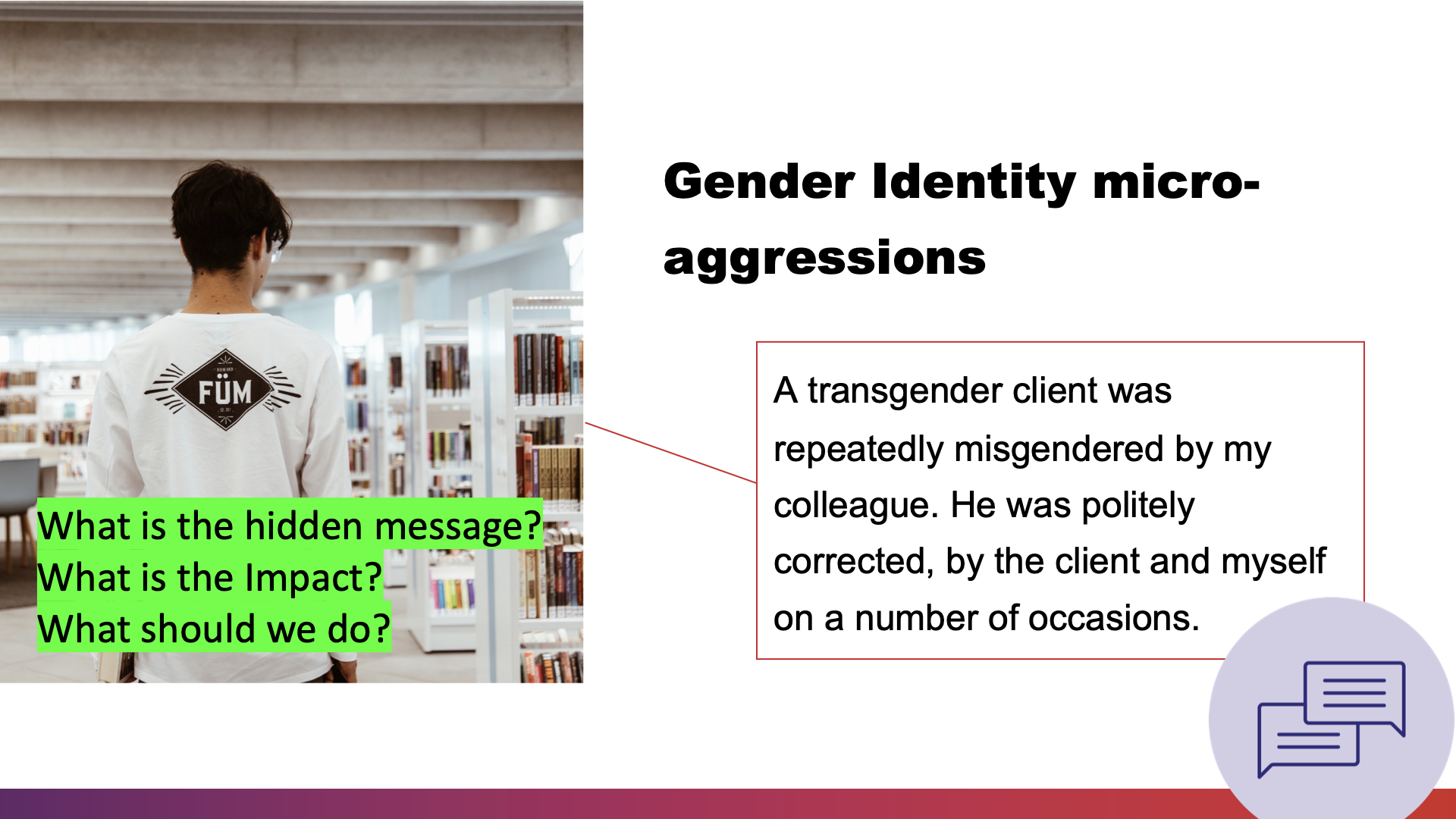Creating a
Consciously Inclusive Culture
Discussion Topics
Breakout Activity One:
Identity and Authenticity Interview
This is a private and confidential activity.
Only share what is comfortable to share.
You have 10 minutes to interview each other, using these questions!
1.What are 5 distinguishing characteristics that make you YOU?
2.Have you ever felt compelled to suppress or hide any of these characteristics?
3.What was the impact of this?
Extra questions to discuss, if you have time:
1.What benefits are there when individuals can bring their authentic selves into the workplace?
2. What makes you feel like you can be yourself at work?
Breakout Activity Two: What do we mean by Psychological Safety?
Instructions
• The person whose first name comes first alphabetically will be the leader.
• The leader will decide on a speaker who will feedback to the whole group, when we return to the Main Room. If you don't want to be the speaker, please choose someone else.
• Avoid specific reference to names when using examples.
• Please make sure that all voices are heard.
How would you define Psychological Safety and what are the benefits to creating and maintaining a psychologically safe environment?
Areas to consider
Individuals feel:
(1) included,
(2) safe to learn,
(3) safe to contribute, and
(4) safe to challenge the status quo,
all without the fear of embarrassment, marginalisation
Breakout Activity Three: Inclusive Communication - Audit
Objectives:
Audit the inclusivity of language and accessibility of communication within your Team(s) to celebrate good practice and highlight areas for improvement.
Consider role specific:
· Methods of communication
· Audience
· Areas of strength
· Areas to enhance
Instructions:
- The person who is born in the latest month of the year will be the leader.
2. The leader will decide on a speaker who will feedback to the whole group, when we return to the Main Room. If you don't want to be the speaker, please choose someone else.
3. Avoid specific reference to names when using examples.
4. Please make sure that all voices are heard.
Your leader will guide you through each of the following questions.
In relation to the inclusivity of written and verbal communication:
- What do you and your team already do well?
2. Is there anything you'd like to do better?
3. What might you or members of your team do differently?
4. What could you do less of, in order for your language and communication to be more inclusive?

Breakout Activity Four:
Subtle Acts of Exclusion (Micro-Aggressions) Confidential Chat
Instructions
The leader for this discussion will be the person who has been with the organisation the longest.
Facilitate an open discussion on the questions below.
This activity is completely confidential and won't be shared on our return to the Main Room.
A speaker isn't needed for this activity.
In either a personal or professional context:
■ Do you have any examples of micro aggressions that you have experienced or witnessed?
■ What was the impact?
■ What action was or should have been taken?
Breakout Activity Five: Stigma
- Your leader for this activity will be the person who was born in the earliest month of the year.
- Your leader will select a speaker for the team, who will share a brief summary of what was discussed. If you prefer not to speak, choose another colleague.
- Your leader will guide the team through the questions below.
- Make sure that all voices are heard - consciously include all members of the team!
Reflect and Discuss:
Is there still stigma around disability? If so, why is this the case?
Consider historical, cultural, social, and psychological factors, such as:
- Historical Perceptions
2. Medical Model Dominance
3. Lack of Representation
4. Fear of the Unknown
5. Inaccessible Environments
6. Cultural Beliefs and Myths
7. Ableism
How can we overcome the stigma?
Additional Reading for Guidance (if needed)
The stigma around disability exists due to a combination of historical, cultural, social, and psychological factors. Here are some key reasons:
1. Historical Perceptions
• In the past, disability was often seen as a tragedy, punishment, or personal failing.
• Disabled individuals were sometimes institutionalized, hidden away, or pitied rather than included and supported.
2. Medical Model Dominance
• The medical model of disability, which views disability as a defect or problem within the person, still influences societal attitudes.
• This model reinforces the idea that disabled people need to be "fixed" or "cured," rather than accommodated or included.
3. Lack of Representation
• Disabled people are often underrepresented or misrepresented in media, education, and leadership.
• When they are visible, portrayals often focus on stereotypes: either as objects of pity (“tragic”) or admiration (“superhuman”).
4. Fear of the Unknown
• Many people feel uncomfortable around disability due to lack of exposure or fear of saying/doing the wrong thing.
• This discomfort can lead to avoidance, exclusion, or discriminatory behaviours.
5. Inaccessible Environments
• When physical and social environments are not inclusive, they reinforce the idea that disabled people don’t belong or can’t participate fully in society.
6. Cultural Beliefs and Myths
• In some cultures, disability is wrongly associated with shame, sin, karma, or divine punishment, further isolating individuals.
7. Ableism
• Ableism is a system of discrimination and prejudice against disabled people. It prioritizes non-disabled norms and marginalizes anyone who doesn't conform.
• It can be overt (e.g., exclusion) or subtle (e.g., low expectations, infantilizing language).
Breakout Activity Six: Receptive/Expressive Communication
Instructions
- The person whose name is last alphabetically will be the leader of this activity.
2. Your leader will decide who will be Speaker A and who will be Speaker B.
3. Your leader will guide you through each part of the activity below.
PART ONE
In a moment, SPEAKER A is going to talk for one minute about their weekend and SPEAKER B is just going to listen.
OK – off you go [1 minute].
And stop!
How did that feel? Easy? Good!
PART TWO
Now, SPEAKER B is going to talk about their weekend for one minute. BUT they are not allowed to use any words containing the letter ‘e’.
Ready? Off you go! [1 minute].
And stop!
How did that feel?
Were you able to speak as fluently as your partner?
How did that make you feel?
SPEAKER A - how did it feel listening as your partner was struggling to put their thoughts into words? Frustrating? Annoying?
Additional Activity Seven: Case Studies
Instructions
- The person born latest in the year will be the leader.
- This is a confidential discussion. No speaker is needed for this activity.
- Please make sure that all voices are heard.
Discuss your role in each scenario below
Case Study One
When Melvin had to leave work early to go to collect their child from school, they explained to a colleague that the child had been bullied by some classmates because of TICS caused by Tourette’s Syndrome.
On their return to the office the next day, some colleagues played what they considered to be a funny game of randomly calling out words, and mimicking tics.
Melvin made it clear that they didn’t appreciate this behaviour but the colleagues continued with their “game” over the coming days. Melvin feels intimidated and dreads going to work.
What is your role as a Leader in this situation?
Case Study Two
Aga has strong interpersonal skills, is well-liked for their sense of humour and wants to move to a more customer-facing role. Aga has exceptional spoken English but a strong Polish accent.
The move is denied by a manager who explains that some customers will struggle to understand them and that this may make them feel uncomfortable.
Was this the correct decision? What would you do differently?
Additional Activity Eight: Subtle Acts of Exclusion (Micro-aggressions)
Instructions:
The leader for this discussion will be the person who most recently joined the organisation.
Guide your team through a discussion about the hidden messages and impact of the 3 Micro-aggression examples below.
A speaker isn't needed for this activity.



















